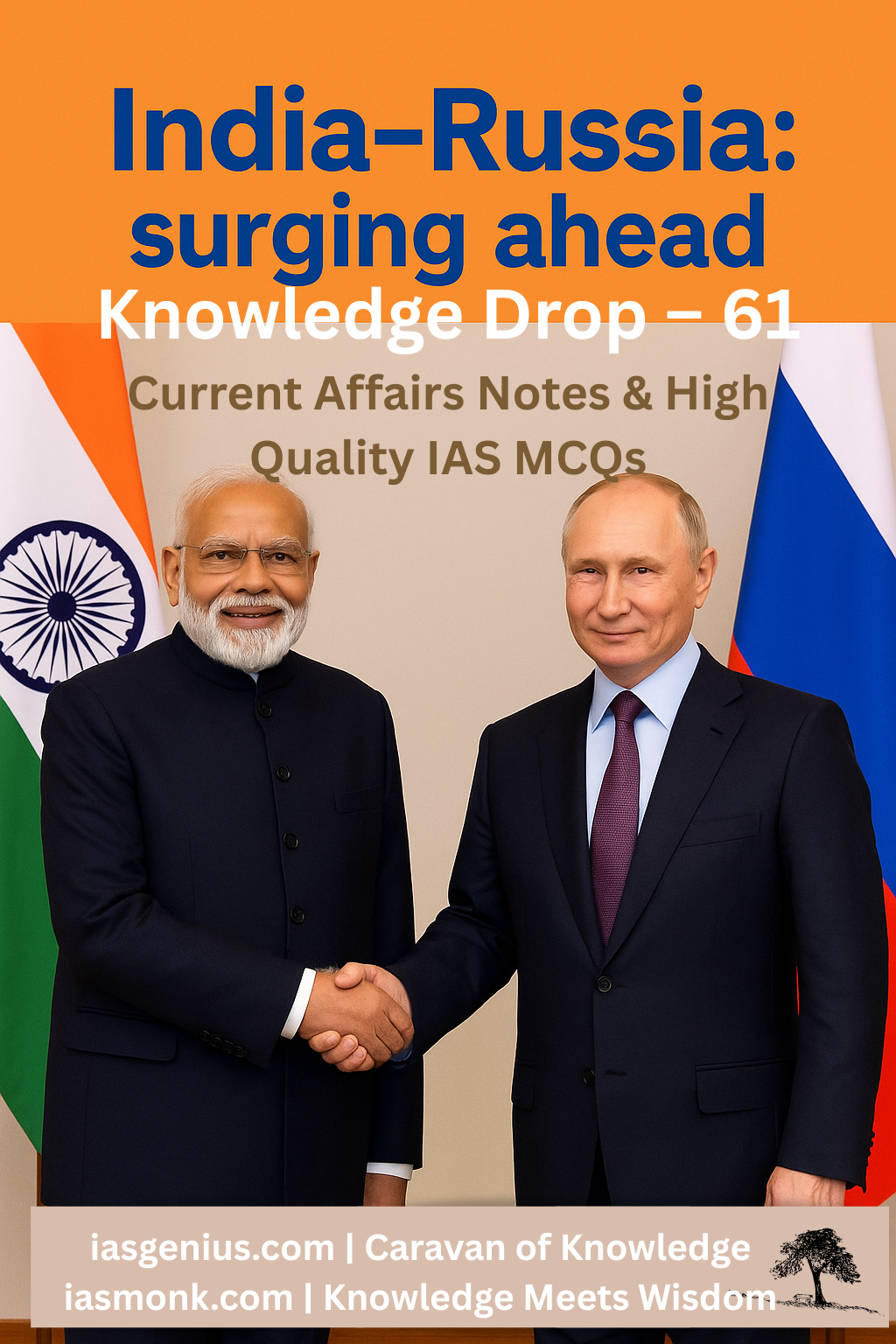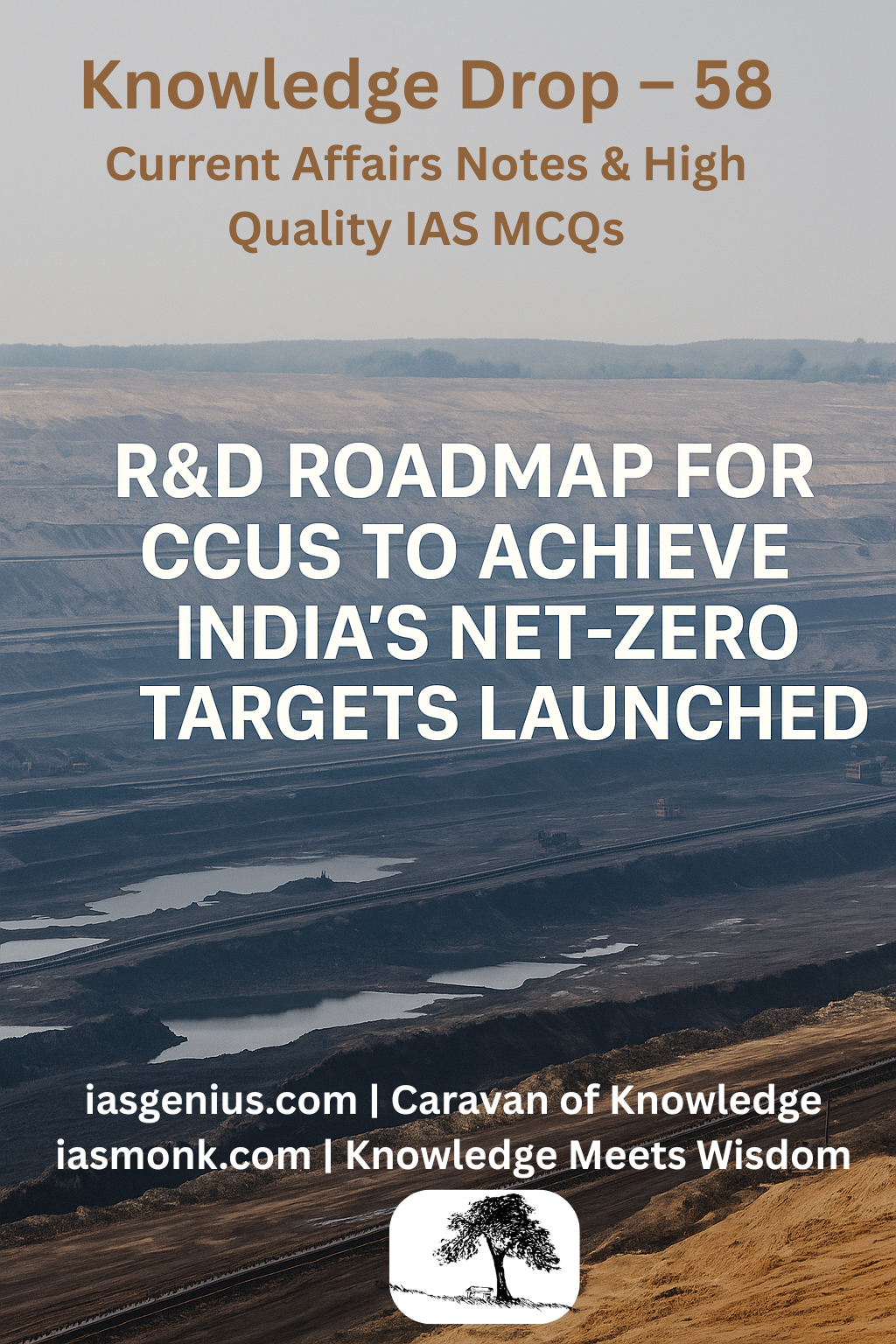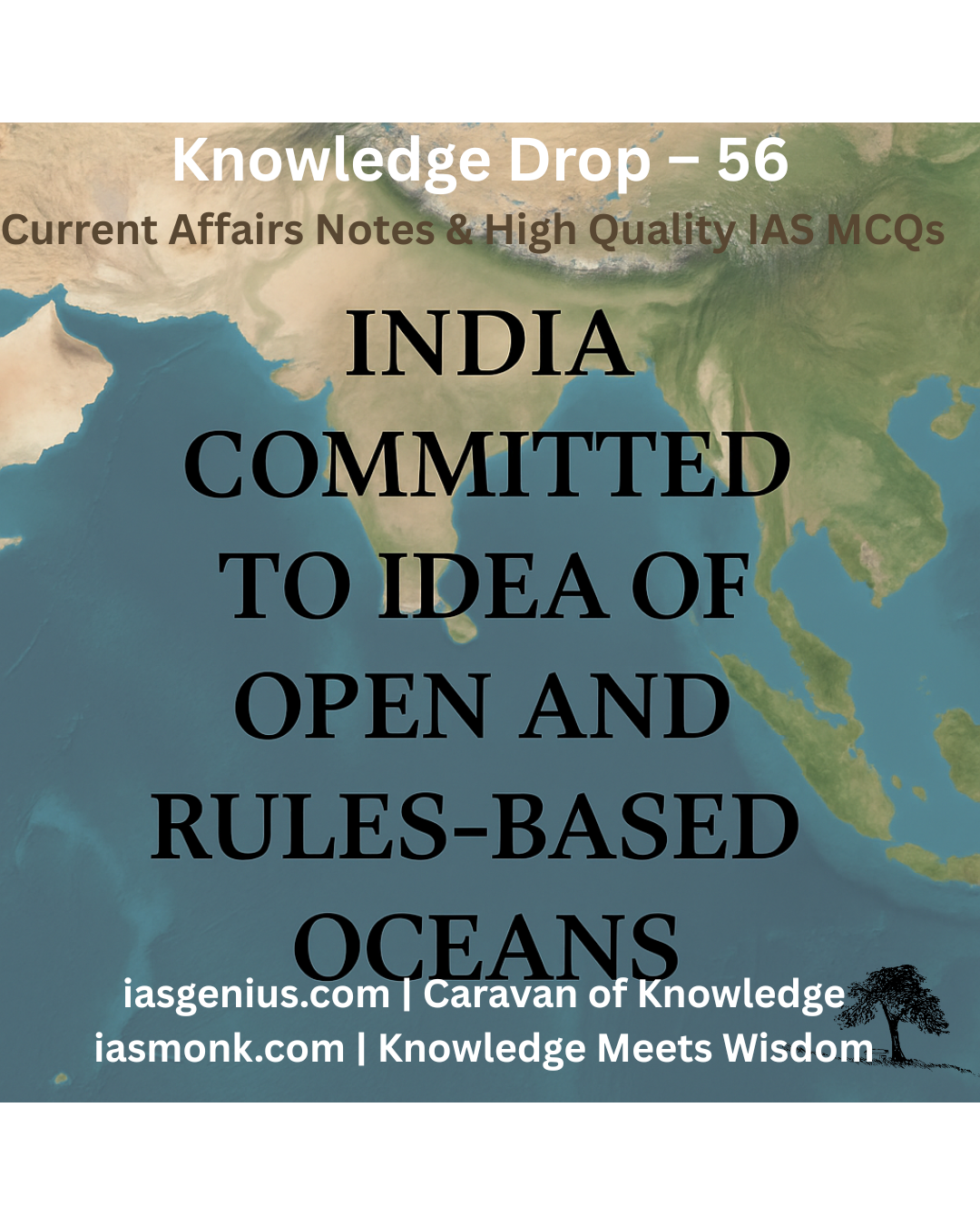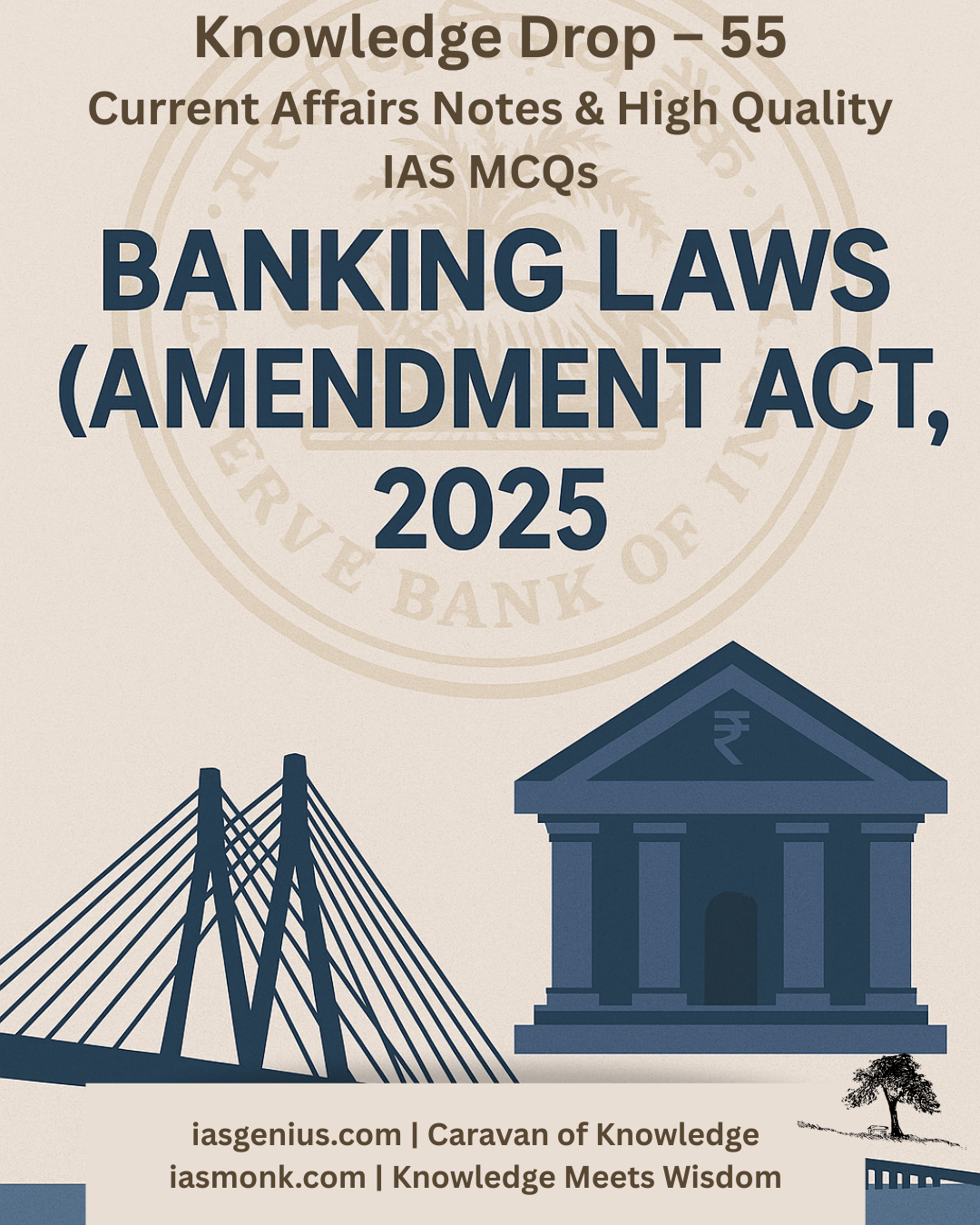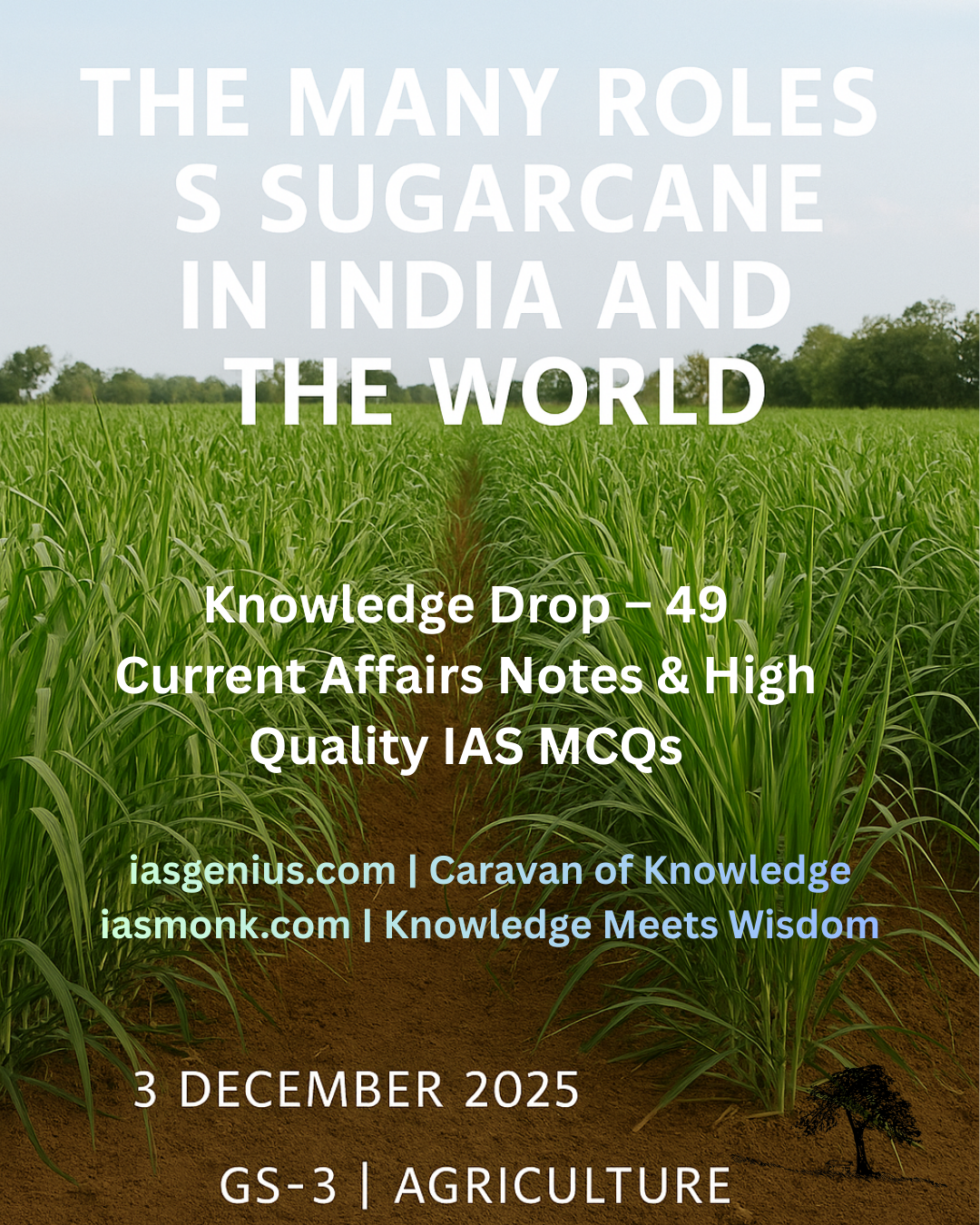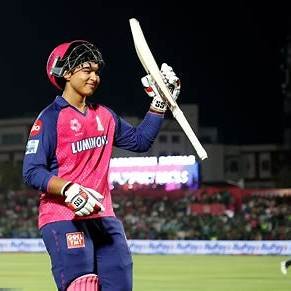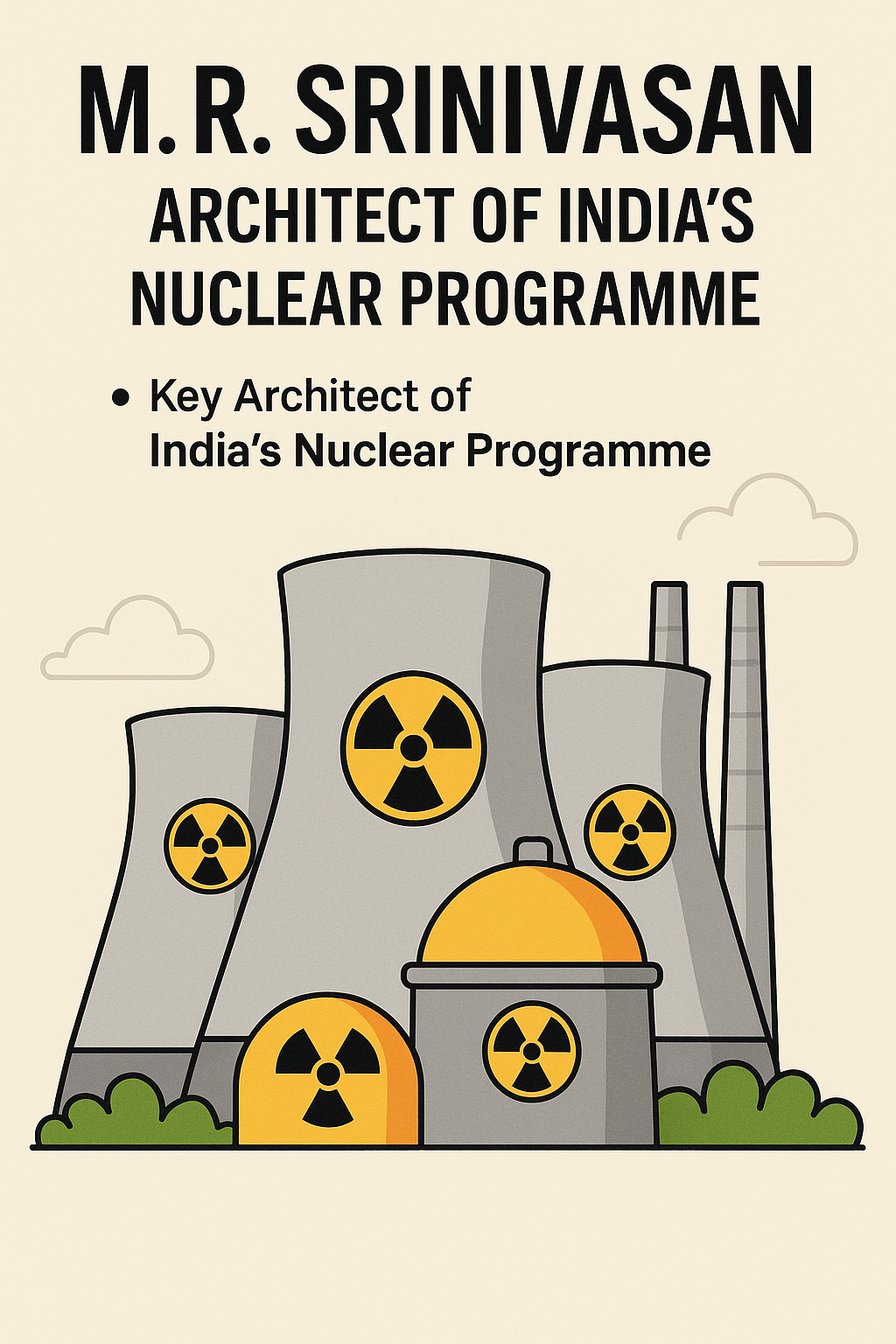
🧭May 25, 2025, Post 3: MR Srinivasan: A Key Architect of India’s Nuclear Programme ⚛️ | High Quality Mains Essay | Prelims MCQs
MR Srinivasan: A Key Architect of India’s Nuclear Programme⚛️

Syllabus: GS3/Science & Technology
Context
India recently mourned the loss of Dr. M.R. Srinivasan, a renowned nuclear scientist and former chairman of the Atomic Energy Commission (AEC), who passed away. Dr. Srinivasan was instrumental in shaping India’s nuclear energy landscape and was a key figure in the development of nuclear power plants and nuclear technology in India. His contributions laid the foundation for India’s nuclear capabilities, both in terms of energy generation and national security.
About Dr. M.R. Srinivasan
- Born: 5th January 1930
Career and Contributions:
- 1955: Joined the Department of Atomic Energy (DAE), working alongside Dr. Homi Bhabha, on India’s first nuclear research reactor, Apsara.
- 1959: Appointed as Principal Project Engineer for India’s first atomic power station.
- 1967: Served as Chief Project Engineer of the Madras Atomic Power Station.
- 1974: Led the Power Projects Engineering Division.
- 1984: Appointed as Chairman of the Nuclear Power Board.
- 1987: Became Chairman of the Atomic Energy Commission and Secretary of the Department of Atomic Energy.
- Founder-Chairman of the Nuclear Power Corporation of India Limited (NPCIL), under which 18 nuclear power units were developed.
Recognition and Legacy:
- Member of the Planning Commission (1996-98).
- Awarded Padma Shri (1984), Padma Bhushan (1990), and Padma Vibhushan (2015).
- Served on the National Security Advisory Board (2002-04, 2006-08).
Dr. Srinivasan’s leadership and vision transformed India’s nuclear energy sector, enabling the country to evolve into a global player in nuclear power and technology.
India’s Nuclear Programme
India’s nuclear programme has been a cornerstone of its energy strategy, balancing self-reliance, technological advancement, and global cooperation. The programme focuses on providing clean energy while ensuring strategic security. India’s approach to nuclear energy has been framed around a three-stage plan:
Historical Development:
- The Atomic Energy Commission (AEC) was established in 1948 under the leadership of Dr. Homi Bhabha.
- The programme was structured around a three-stage plan:
- Stage I: Pressurized Heavy Water Reactors (PHWRs) using natural uranium.
- Stage II: Development of Fast Breeder Reactors (FBRs) to generate plutonium.
- Stage III: Deployment of Advanced Thorium Reactors, leveraging India’s vast thorium reserves.
India holds 21% of the world’s thorium reserves, and projects like Bhavani aim to harness this resource for future power generation.
Current Status
- Installed Capacity: As of 2024, India operates 23 nuclear reactors across seven power plants, contributing 8,180 MW to the national grid (up from 4,780 MW in 2014).
- India aims to reach 22,480 MW by 2031-32.
Energy Mix and Role of Nuclear Power
India is undergoing a renewable energy transition, and nuclear power plays a crucial role in reducing the country’s dependence on fossil fuels while meeting its growing energy demand. Nuclear power’s contribution is expected to increase as part of India’s clean energy strategy.
The revised nuclear electricity distribution framework allocates 50% of nuclear-generated electricity to home states, 35% to neighboring states, and 15% to the national grid.
Recent Advancements
- Prototype Fast Breeder Reactor (PFBR): India has entered Stage II of its nuclear programme with the core-loading of the PFBR at Kalpakkam.
- Expansion Plans: 10 new reactors have been approved, and India is exploring private sector participation to accelerate growth, including the development of Bharat Small Modular Reactors (BSMRs).
- International Collaborations: India has signed agreements with countries like Russia, France, and the U.S. for nuclear technology exchange, which will facilitate advancements in nuclear energy technology and security.
GS Paper Mapping
- GS 3: Science & Technology, Energy, Nuclear Technology
- GS 2: International Relations, Technology Diplomacy
- GS 1: Indian Society (Contributions of prominent personalities)
IAS Monk’s Whisper
“In the realm of nuclear energy, true progress is not just measured in the kilowatts generated but in the vision of those who dare to transform energy into power. Dr. M.R. Srinivasan’s legacy reminds us that mastery over energy is not just a scientific achievement—it is the foundation for a country’s future prosperity.” ⚛️🌍
High Quality Mains Essay For Practice :
Word Limit 1000-1200
India’s Nuclear Programme: Past, Present, and Future ⚛️
Introduction
India’s nuclear programme has evolved over several decades from being a humble scientific curiosity to a key component of the nation’s energy strategy, strategic defense, and technological advancement. India’s nuclear energy journey has been marked by self-reliance, technological innovations, and international collaborations. Despite numerous challenges—including economic sanctions, political opposition, and technological hurdles—India has developed a strong nuclear energy capacity. This essay explores the past, present, and future of India’s nuclear programme, focusing on its energy contribution, strategic importance, and prospects for future growth.
Past: The Birth of India’s Nuclear Vision
India’s nuclear journey began with the visionary leadership of Dr. Homi Bhabha, who laid the foundation for the country’s nuclear programme in the late 1940s. The establishment of the Atomic Energy Commission (AEC) in 1948 under Dr. Bhabha’s leadership marked the beginning of India’s nuclear ambitions. Dr. Bhabha’s vision was clear: to harness nuclear energy for peaceful purposes, ensuring energy self-sufficiency while advancing the country’s technological and scientific capabilities.
The first step was the development of a nuclear research reactor. India’s first nuclear reactor, Apsara, was commissioned in 1956 at the Bhabha Atomic Research Centre (BARC) in Mumbai. This reactor was an important milestone, providing the country with the ability to conduct nuclear research and experiments. Over the following decades, India made steady progress in nuclear research, and in 1967, it constructed the Madras Atomic Power Station, which became India’s first nuclear power plant.
India’s nuclear ambitions took a significant turn in 1974, when the country conducted its first nuclear test, known as Smiling Buddha, at the Pokhran Test Range in Rajasthan. This underground test, though controversial on the international stage, signified India’s nuclear deterrence capability and demonstrated the country’s ability to produce nuclear weapons. Despite being criticized by the global community and facing sanctions, India remained resolute in its pursuit of nuclear technology for both peaceful energy generation and strategic defense.
Present: India’s Nuclear Energy Landscape
India’s nuclear energy programme has grown significantly since its inception, positioning the country as a global player in the nuclear sector. As of 2024, India operates 23 nuclear reactors across seven power plants, with a total installed capacity of 8,180 MW. The country’s nuclear power generation has steadily increased from 4,780 MW in 2014, contributing to its overall energy mix. However, nuclear power still constitutes a modest portion of India’s total electricity generation, with renewables and coal remaining dominant sources.
India’s nuclear programme is structured around a three-stage nuclear strategy, which was conceptualized by Dr. Homi Bhabha in the 1950s and 1960s. The three-stage plan was designed to ensure long-term energy sustainability using India’s vast natural resources of uranium and thorium. These stages are:
- Stage I: The first stage focuses on the use of Pressurized Heavy Water Reactors (PHWRs) using natural uranium. This stage is already operational, with several PHWRs in place across India.
- Stage II: The second stage involves the use of Fast Breeder Reactors (FBRs), which would generate plutonium and breed more fuel from uranium. This would help increase the efficiency of nuclear reactors and enable India to use its nuclear resources more effectively.
- Stage III: The third stage involves the development and use of Advanced Thorium Reactors, leveraging India’s rich thorium reserves. India holds 21% of the world’s thorium reserves, and projects like the Bhavani reactor aim to tap into this resource for clean and sustainable nuclear power.
India has made significant strides in this three-stage approach, with the completion of several PHWRs, the development of the Prototype Fast Breeder Reactor (PFBR) at Kalpakkam, and thorium-based research reactors. However, challenges in technological development, funding, and international collaborations continue to persist.
Current Challenges and India’s Strategic Position
India’s nuclear energy programme, though impressive, faces several significant challenges. One of the biggest hurdles is the limited expansion of nuclear energy despite the country’s vast nuclear potential. As of now, nuclear power contributes around 2-3% of India’s total electricity generation, a far cry from the potential share of 25-30% projected by the government.
- Cost of Nuclear Power: Nuclear power generation remains expensive due to the high upfront cost of constructing reactors, the complex technology required for safety, and the need for continuous investment in nuclear waste management and security. While India has the technology to build and operate reactors, international financial assistance and collaboration are needed for scaling up the programme.
- Safety Concerns: The Fukushima disaster of 2011 and ongoing safety concerns around nuclear energy continue to fuel public apprehension about nuclear power in India. While nuclear safety standards have significantly improved, the challenge lies in ensuring public trust and addressing safety concerns in densely populated regions.
- Nuclear Waste Management: Another significant challenge facing India’s nuclear programme is the management of radioactive waste. Although India has made progress in developing safe waste disposal methods, long-term solutions for waste management remain a complex and costly challenge.
- International Restrictions: India’s nuclear programme was initially constrained by international sanctions, especially after the Pokhran tests in 1974. However, India’s membership in the Nuclear Suppliers Group (NSG), its nuclear cooperation agreements with countries like Russia, France, and the United States, and its role in the International Atomic Energy Agency (IAEA) have allowed India to access advanced nuclear technology and materials.
Despite these challenges, India has maintained a strong stance on its nuclear autonomy and continues to push forward with its development of indigenous nuclear technology. The recent core-loading of the Prototype Fast Breeder Reactor (PFBR) and the construction of 10 new reactors demonstrate India’s ongoing commitment to expanding its nuclear capacity.
Future: India’s Nuclear Energy Outlook
Looking ahead, India’s nuclear programme is poised for substantial growth, driven by the country’s increasing demand for clean and reliable energy. India’s growing population and expanding economy necessitate a diversified energy mix that includes both renewables and nuclear energy.
The future of India’s nuclear programme is tied to several key factors:
- Nuclear Energy Expansion: India has already planned the construction of 10 new nuclear reactors, which will help increase its installed nuclear capacity to around 22,480 MW by 2031-32. The introduction of Small Modular Reactors (SMRs), a new class of compact reactors, is expected to further boost nuclear energy capacity while reducing costs and safety concerns.
- Thorium-Based Energy: As part of its long-term vision, India is focusing on thorium-based reactors that will not only provide a sustainable energy source but also reduce dependence on uranium imports. The use of Advanced Heavy Water Reactors (AHWRs) and thorium fuel cycles could revolutionize India’s nuclear energy capacity and contribute to global clean energy goals.
- International Collaborations: India’s nuclear programme will benefit significantly from ongoing international collaborations. Agreements with countries like Russia, France, and the United States will help India access cutting-edge nuclear technology, support the development of Fast Breeder Reactors (FBRs), and provide financial backing for future nuclear plants.
- Public and Political Support: For India to successfully transition to a nuclear-powered future, it will need continued public and political support. Addressing safety concerns, ensuring transparency, and educating the public about the benefits of nuclear energy will be critical in garnering broader acceptance.
Conclusion
India’s nuclear programme has come a long way since its inception in the mid-20th century. It has evolved from a small research initiative to a robust energy sector capable of meeting the country’s growing energy needs. While challenges remain, particularly with respect to cost, safety, and international relations, India’s determination to develop nuclear power for peaceful purposes is unwavering. The future of India’s nuclear programme looks promising, with technological advancements, increased capacity, and international cooperation paving the way for a clean, secure, and sustainable energy future.
As India continues to expand its nuclear energy capacity, it will be better positioned to meet its climate goals and energy needs, playing a crucial role in the global push for clean energy solutions.
“In the quest for power, both nuclear and otherwise, true strength lies not just in harnessing energy, but in understanding the balance between progress and responsibility. As we power our future, may we always remember that the brightest light is the one that illuminates the path to sustainability.” ⚡🌍
Target IAS-26: Daily MCQs :
📌 Prelims Practice MCQs
Topic: India’s Nuclear Programme
MCQ 1 – Type 1: How many of the above statements are correct?
Consider the following statements regarding India’s nuclear programme:
1. Dr. M.R. Srinivasan was the founder-chairman of the Nuclear Power Corporation of India Limited (NPCIL).
2. India’s nuclear programme is solely based on uranium as a fuel source.
3. India is projected to increase its nuclear capacity to 22,480 MW by 2031-32.
4. India’s current nuclear energy generation contributes around 20% of its total electricity generation.
How many of the above statements are correct?
A) Only one
B) Only two
C) Only three
D) All four
🌀 Didn’t get it? Click here (▸) for the Correct Answer & Explanation
✅ Correct Answer: B) Only two
🧠 Explanation:
• 1) ✅ True – Dr. M.R. Srinivasan was indeed the founder-chairman of NPCIL.
• 2) ❌ False – India’s nuclear programme is based on both uranium and thorium (particularly for Stage III reactors).
• 3) ✅ True – India aims to increase its nuclear capacity to 22,480 MW by 2031-32.
• 4) ❌ False – Nuclear energy contributes around 2-3% of India’s total electricity generation, not 20%.
MCQ 2 – Type 2: Two-Statement Type
Consider the following two statements:
1. The primary focus of India’s nuclear programme is to develop Fast Breeder Reactors (FBRs).
2. India’s nuclear power plants currently use mostly solar energy as fuel.
Which of the above statements is/are correct?
A) Only 1 is correct
B) Only 2 is correct
C) Both are correct
D) Neither is correct
🌀 Didn’t get it? Click here (▸) for the Correct Answer & Explanation
✅ Correct Answer: A) Only 1 is correct
🧠 Explanation:
• • 1) ✅ True – India’s nuclear programme focuses on Fast Breeder Reactors (FBRs) for Stage II of its nuclear strategy.
• 2) ❌ False – India’s nuclear power plants primarily rely on uranium and plutonium, not solar energy.
MCQ 3 – Type 3: Code-Based Correct Statement Selection
Which of the following statements regarding India’s nuclear programme are correct?
1. India is developing Advanced Thorium Reactors (ATRs) as part of its long-term nuclear energy strategy.
2. India has no plans to phase out coal power by 2040.
3. India is part of the Nuclear Suppliers Group (NSG), allowing access to nuclear technology.
4. India’s nuclear energy policy does not involve international collaborations.
Select the correct code:
A) 1, 2, and 3 only
B) 1 and 3 only
C) 2, 3, and 4 only
D) 1, 3, and 4 only
🌀 Didn’t get it? Click here (▸) for the Correct Answer & Explanation
✅ Correct Answer: B) 1 and 3 only
🧠 Explanation:
• 1) ✅ True – India is indeed focused on developing Advanced Thorium Reactors (ATRs), especially given its abundant thorium reserves.
• 2) ❌ False – India does plan to phase out coal power entirely by 2040.
• 3) ✅ True – India is a member of the Nuclear Suppliers Group (NSG), which provides access to nuclear technology and fuel.
• 4) ❌ False – India’s nuclear programme involves significant international collaboration, particularly with countries like Russia, France, and the U.S..
MCQ 4 – Type 4: Direct factual question
What is the primary challenge India faces in expanding its nuclear power capacity?
A) Lack of trained nuclear engineers
B) High costs associated with nuclear power plant construction and maintenance
C) Lack of natural resources like uranium
D) Political opposition from the public
🌀 Didn’t get it? Click here (▸) for the Correct Answer & Explanation.
✅ Correct Answer: B) High costs associated with nuclear power plant construction and maintenance
🧠 Explanation:
• B) ✅ True – The high upfront costs of building nuclear power plants, along with maintenance and safety measures, remain the most significant challenges to expanding India’s nuclear energy capacity.
• A) ❌ False – India has a substantial number of skilled nuclear engineers.
• C) ❌ False – While uranium is an important fuel source, India is focusing on both uranium and thorium as fuel sources, reducing dependency on uranium.
• D) ❌ False – While public perception can be a challenge, it is not the primary challenge to nuclear energy expansion in India.

